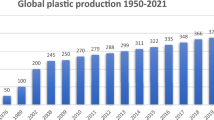Summary
By means of gas chromatography, gas chromatographic coupled mass spectrometry, trail-following experiments and electrophysiological recordings from worker antennae, the major trail pheromone components from the hindgut of the formicine speciesCamponotus atriceps andC. floridanus were identified as 3,5-dimethyl-6-(1′-methylpropyl)-tetrahydropyran-2-one and nerolic acid, respectively. The Dufour's gland contents of both species, investigated by gas chromatographic coupled mass spectrometry, show significant differences.
Similar content being viewed by others
References
Akre RD, Hansen KD (1990) Management of carpenter ants. Pp 693–700in Vander Meer RK, Jaffe K, Cedeno A (eds) Applied Myrmecology. Boulder/CO, San Francisco/CA, GB-Oxford: Westview Press
Ali MF, Billen JPJ, Jackson BD, Morgan ED (1988) Secretion of the Dufour gland of two African desert ants,Camponotus aegyptiacus andCataglyphis savignyi (Hymenoptera: Formicidae). Biochem Syst Ecol 16:647–654
Attygalle AB, Herrig M, Vostrowsky O, Bestmann HJ (1987) A technique for injecting intact glands for analysis of sex pheromones of Lepidoptera by capillary gas chromatography: reinvestigation of the pheromone complex ofMamestra brassicae. J Chem Ecol 13:1299–1311
Attygalle AB, Morgan ED (1988) Pheromones in nanogram quantities: structure determination by combined microchemical and gas chromatographic methods. Angew Chem Int Ed Eng 27:460–478
Bagnéres A-G, Morgan ED, Clement J-L (1991) Species-specific secretion of the Dufour glands of three species of formicine ants (Hymenoptera: Formicidae). Biochem Syst Ecol 19:25–33
Bergström G, Kullenberg B, Ställberg-Stenhagen S, Stenhagen E (1968) Studies on natural odoriferous compounds. II. Identification of a 2,3-dihydrofarnesol as the main component of the marking perfume of male bumble bees of the speciesBombus terrestris L. Arkiv för Kemi 28:453–469
Bestmann HJ, Haak U, Kern F, Hölldobler B (1995) 2,4-Dimethyl-5-hexanolide, a trail pheromone component of the carpenter antCamponotus herculeanus (Hymenoptera: Formicidae: Formicinae). Naturwissenschaften 82:142–144
Bolton B (1995a) A taxonomic and a zoogeographical census of extant ant taxa (Hymenoptera: Formicidae). J Nat Hist 29: 1039–1056
Bolton B (1995b) A New General Catalogue of the Ants of the World. Cambridge/MA: Harvard University Press
Brown WV, Moore BP (1979) Volatile secretory products of an Australian formicine ant of the genusCalomyrmex (Hymenoptera: Formicidae). Insect Biochem 9:451–460
Cantwell SG, Lau EP, Watt DS, Fall RR (1978) Biodegradation of acyclic isoprenoids byPseudomonas species. J Bacteriol 135:324–333
Carlin NF, Hölldobler B (1986) The kin recognition system of carpenter ants (Camponotus spp.). I. Hierachical uses in small colonies. Behav Ecol Sociobiol 19:123–134
Corey EJ, Gilman NW, Ganem BE (1968) New Methods for the oxidation of aldehydes to carboxylic acids and esters. JACS 90: 5616–5617
Décombe J (1936) Préparation de cétonesβ-chloréthylées et des cétonesβ-vinylées. C R hebd Seanc Acad Sci Paris 202:1685–1687
Dev S, Rai C (1957) Organic reactions with polyphosphoric acid. Part V. Intramolecular acylation with lactones: cyclo pentenones from ∂-lactones. J Ind Chem Soc 34:266–274
Deyrup MA, Carlin N, Trager J, Umphrey G (1988) A review of the ants of the Florida Keys. Fla Entomol 71:163–176
Francis GW, Veland K (1981) Alkylthiolation for the determination of double-bond position in linear alkenes. J Chromatrogr 219:379–384
Hashmi AA (1973) A revision of the Neotropical ant subgenusMyrmothrix of the genusCamponotus (Hymenoptera: Formicidae). Studia Entomol 16:1–140
Hoffman JM, Schlessinger RH (1971) Sodium metaperiodat: a milk oxidizing agent for the generation of di-imide from hydrazine. Chem Comm 00:1245–1246
Hölldobler B (1962) Über die forstliche Bedeutung der Roβameisen. Waldhygiene 4:228–250
Hölldobler B, Wilson EO (1990) The Ants. Cambridge/MA: Belknap-Press of Harvard University and D-Heidelberg: Springer Verlag
Honkanen E, Moisio T, Krvonen P (1969) Mass spectra of some branched-chain aliphatic lactones. Acta Chem Scand 23:531–536
Ikan R, Gottlieb R, Bergmann ED, Ishay J (1969) The pheromone of the queen of the oriental hornet,Vespa orientalis. J Insect Physiol 15:1708–1712
Kern F, Bestmann HJ (1993) Antennal electrophysiological responsiveness of the Ponerinae antLeptogenys diminuta to trail and recruitement pheromones and its structure analogs. Naturwissenschaften 80:424–427
Kern F, Janssen E, Bestmann HJ, Schäfer D, Klein RW, Maschwitz U, Attygalle AB Mellein, A trail pheromone component of the antLasius fuliginosus (Formicidae, Formicinae). J Chem Ecol: in press
Ledl F, Schleicher E (1990) New aspects of the Maillard reaction in foods and in the human body. Angew Chem Int Ed Engl 29:565–594
Lloyd HA, Schmuff NR, Hefetz A (1984) Chemistry of the male mandibular gland secretion of the carpenter ant,Camponotus thoracicus fellah Emery. Comp Biochem Physiol 78B:687–689
Morgan ED, Wadhams LJ (1972) Gas chromatography of volatile compounds in small samples of biological materials. J Chromatogr Sci 10:528–529
Pickett JA, Williams IH, Martin AP, Smith MC (1980) Nasonov pheromone of the honey bee,Apis mellifera L. (Hymenoptera: Apidae). Part I. Chemical characterization. J Chem Ecol 6:425–434
Pinyarat W, Mori K (1993) Synthesis of 2,4-dimethyl-5-hexanolide, 2,4-dimethyl-5-heptanolide and 2,4-dimethyl-5-octanolide, the lactones identified in volatiles from the heads of the male black garden ant,Lasius niger. Biosci Biotechnol Biochem 57:419–421
Rocca JR, Tumlinson JH, Glancey BM, Lofgren CS (1983) Synthesis and stereochemistry of tetrahydro-3,5-dimethyl-6-(1-methyl-butyl(-2H-pyran-2-one, a component of the queen recognition pheromone ofSolenopsis invicta. Tetrahedron Lett 24:1893–1896
Schildknecht H (1976) Chemical ecology — a chapter of modern natural products chemistry. Angew Chem Int Ed Engl 15:214–222
Steghaus-Kovacs S, Maschwitz U, Attygalle AB, Frighetto R, Frighetto N, Vostrowsky O, Bestmann HJ (1992) Trail-following responses ofLeptogenys diminuta to stereoisomers of 4-methyl-3-heptanol. Experientia 48:690
Swedenborg PD, Jones RL, Liu H-W, Krick TP (1993) (3R*, 5S*,6R*)-3,5-dimethyl-6-(methylethyl)-3,4,5,6-tetrahydropyran-2-one, a third sex pheromone component forMacrocentrus grandii (Goidanich) (Hymenoptera: Brachonidae) and evidence for its utility at eclosion. J Chem Ecol 19:485–502
Übler E, Kern F, Bestmann HJ, Hölldobler B, Attygalle AB (1995) Trail pheromone of two formicine ants,Camponotus silvicola andC. rufipes (Hymenoptera: Formicidae). Naturwissenschaften 82:523–525
Wheeler JW, Evans SL, Blum MS, Velthuis HHV, de Carmago JMF (1976)Cis-2-methyl-5-hydroxyhexanoic acid lactone in the mandibular gland secretion of a carpenter bee. Tetrahedron Lett 45:4029–4032
Author information
Authors and Affiliations
Additional information
Pheromones 104: Janssen E, Übler E, Bauriegel L, Kern F, Bestmann H-J, Attygalle AB, Steghaus-Kovacs S, Maschwitz U: Trail pheromone of the Ponerinae antLeptogenys peuqueti (Hymenoptera: Formicidae): a multicomponent mixture of related compounds
Rights and permissions
About this article
Cite this article
Haak, U., Hölldobler, B., Bestmann, H.J. et al. Species-specificity in trail pheromones and Dufour's gland contents ofCamponotus atriceps andC. floridanus (Hymenoptera: Formicidae). Chemoecology 7, 85–93 (1996). https://doi.org/10.1007/BF01239485
Issue Date:
DOI: https://doi.org/10.1007/BF01239485




